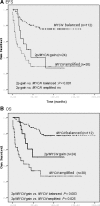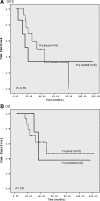2p24 Gain region harboring MYCN gene compared with MYCN amplified and nonamplified neuroblastoma: biological and clinical characteristics
- PMID: 20395439
- PMCID: PMC2877825
- DOI: 10.2353/ajpath.2010.090624
2p24 Gain region harboring MYCN gene compared with MYCN amplified and nonamplified neuroblastoma: biological and clinical characteristics
Abstract
Although the role of MYCN amplification in neuroblastoma is well established, the biological and clinical characteristics of the 2p gain region harboring the MYCN gene remain unclear. The aim of this study was to compare the biological and clinical characteristics of these tumors with MYCN amplified and nonamplified neuroblastoma and to determine their impact on disease outcome. Samples from 177 patients were analyzed by fluorescence in situ hybridization, including MYCN, 1p, 17q, and 11q regions; 2p gain was identified in 25 patients, MYCN amplification in 31, and no amplification in 121 patients. Patients with 2p gain had a significantly worse 5-year event-free survival rate than patients with no MYCN amplified (P < 0.001), and an intermediate 5-year overall survival rate difference existed between the MYCN amplified tumors (P = 0.025) and nonamplified (P = 0.003) groups. All of the 2p gain samples were associated with segmental and/or numerical alterations in the other tested regions. The presence of segmental alterations with or without MYCN amplification was recently found to be the strongest predictor of relapse in a multivariate analysis. The results of the present study suggest that the determination of MYCN gene copy number relative to chromosome 2, when evaluating MYCN status at diagnosis, may help to reveal the underlying genetic pattern of these tumors and better understand their clinical behavior.
Figures



Similar articles
-
The genetic and clinical significance of MYCN gain as detected by FISH in neuroblastoma.Pediatr Surg Int. 2011 Mar;27(3):231-6. doi: 10.1007/s00383-010-2781-4. Pediatr Surg Int. 2011. PMID: 21046119
-
Comparative genetic study of intratumoral heterogenous MYCN amplified neuroblastoma versus aggressive genetic profile neuroblastic tumors.Oncogene. 2016 Mar 17;35(11):1423-32. doi: 10.1038/onc.2015.200. Epub 2015 Jun 29. Oncogene. 2016. PMID: 26119945
-
Copy number gain of MYCN gene is a recurrent genetic aberration and favorable prognostic factor in Chinese pediatric neuroblastoma patients.Diagn Pathol. 2013 Jan 15;8:5. doi: 10.1186/1746-1596-8-5. Diagn Pathol. 2013. PMID: 23320395 Free PMC article.
-
Neuroblastoma and MYCN.Cold Spring Harb Perspect Med. 2013 Oct 1;3(10):a014415. doi: 10.1101/cshperspect.a014415. Cold Spring Harb Perspect Med. 2013. PMID: 24086065 Free PMC article. Review.
-
Stage 4S Neuroblastoma: What Are the Outcomes? A Systematic Review of Published Studies.Eur J Pediatr Surg. 2021 Oct;31(5):385-389. doi: 10.1055/s-0040-1716836. Epub 2020 Sep 15. Eur J Pediatr Surg. 2021. PMID: 32932540
Cited by
-
Cross-Cohort Analysis Identifies a TEAD4-MYCN Positive Feedback Loop as the Core Regulatory Element of High-Risk Neuroblastoma.Cancer Discov. 2018 May;8(5):582-599. doi: 10.1158/2159-8290.CD-16-0861. Epub 2018 Mar 6. Cancer Discov. 2018. PMID: 29510988 Free PMC article.
-
Opportunities and challenges of circulating biomarkers in neuroblastoma.Open Biol. 2019 May 31;9(5):190056. doi: 10.1098/rsob.190056. Open Biol. 2019. PMID: 31088252 Free PMC article. Review.
-
Application of the FISH method and high-density SNP arrays to assess genetic changes in neuroblastoma-research by one institute.Acta Biochim Pol. 2024 Jul 10;71:12821. doi: 10.3389/abp.2024.12821. eCollection 2024. Acta Biochim Pol. 2024. PMID: 39049899 Free PMC article.
-
Sustained Response to Entrectinib in an Infant With a Germline ALKAL2 Variant and Refractory Metastatic Neuroblastoma With Chromosomal 2p Gain and Anaplastic Lymphoma Kinase and Tropomyosin Receptor Kinase Activation.JCO Precis Oncol. 2022 Jan;6:e2100271. doi: 10.1200/PO.21.00271. JCO Precis Oncol. 2022. PMID: 35085006 Free PMC article. No abstract available.
-
Early Use of Dinutuximab Beta in Patients with High-Risk Neuroblastoma.Case Rep Pediatr. 2021 Jun 19;2021:6610955. doi: 10.1155/2021/6610955. eCollection 2021. Case Rep Pediatr. 2021. PMID: 34239748 Free PMC article.
References
-
- Maris JM, Matthay KK. Molecular biology of neuroblastoma. J Clin Oncol. 1999;17:2264–2279. - PubMed
-
- Brodeur GM. Neuroblastoma: biological insights into a clinical enigma. Nat Rev Cancer. 2003;3:203–216. - PubMed
-
- London WB, Castleberry RP, Matthay KK, Look AT, Seeger RC, Shimada H, Thorner P, Brodeur G, Maris JM, Reynolds CP, Cohn S. Evidence for an age cut-off greater 365 days for than neuroblastoma risk group stratification in the Children’s Oncology Group. J Clin Oncol. 2005;23:6459–6465. - PubMed
-
- Brodeur GM, Pritchard J, Berthold F, Carlsen NLT, Castel V, Castelberry RP, De Bernardi B, Evans AE, Favrot M, Hedborg F, Kaneko M, Kemshead J, Lampert F, Lee REJ, Look AT, Pearson ADJ, Philip T, Roald B, Sawada T, Seeger RC, Tsuchida Y, Voûte PA. Revisions of the international criteria for neuroblastoma diagnosis, staging, and response to treatment. J Clin Oncol. 1993;11:1466–1477. - PubMed
-
- Shimada H, Ambros I, Dehner L, Hata J, Joshi VV, Roald B, Stram DO, Gerbing RB, Lukens JN, Matthay KK, Castleberry RP. The International Neuroblastoma Pathology Classification (the Shimada System). Cancer. 1999;86:364–372. - PubMed
MeSH terms
Substances
LinkOut - more resources
Full Text Sources
Medical

